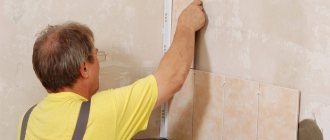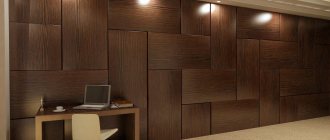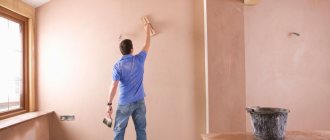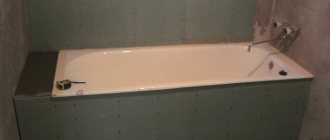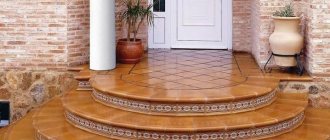Rough finish
It is most common to rent out high-rise buildings with rough finishing. Thus, the owners pay exclusively for construction and installation work. The walls, ceiling and floor, protected by an external door, become the property. At the same time, there are no internal doorways, and the windows are inserted without ebbs and window sills. Only extreme people will move in and live in such an apartment.
Rough finishing speeds up the commissioning of a property and reduces the cost of the final cost of housing.
However, even with rough finishing, developers make mistakes. When handing over an object, be sure to check:
- Verticality of walls by level.
- No through holes to the upper and lower floors.
- Availability of sewer and water risers, without internal wiring.
- Bringing electrical wiring to the apartment.
- Availability of gas pipes (if provided for by the design and number of floors of the building).
- Presence of rough screed. The floor should not have potholes or bumps from the remains of building materials.
- Presence of an entrance door. Even with a rough finish, it should protect your home from unauthorized entry.
- Availability of windows and balcony doors. In budget houses they can be made of wood, although it is common to install plastic ones.
- Availability of radiators and connection to the heating network.
As you can see, those who decide to buy an apartment with a rough finish will have to spend a lot of time, effort and finances to bring the premises into a residential form. Sometimes, due to the lack of all of the above, a new building stands for several years without repair.
When the work is finished
Complete pre-cleaning is a great intermediate option. The disadvantages of preliminary finishing include its significant cost, however, these costs are compensated for in the further design of the apartment. Pre-finishing jobs are popular among mortgage lenders, young families and first-time homebuyers. This is due to the fact that this category of buyers, who invest in the acquisition of living space with all their money, want to spend a little time on the final renovation. Finishing work allows the owner to create the interior of the apartment to his liking, without being distracted by additional work.
When accepting housing, pay attention to the quality of finishing work:
- The floor must be ready for any type of flooring.
- The walls should not have any defects that could prevent wallpaper or tiles from peeling off. Windows and balcony doors must not be mechanically damaged. The mounting foam must be covered with protective waterproof tape. It is also necessary to check the window accessories; their opening and closing should occur without serious effort.
- Heating. Checking the connection of heating devices to the central heating system, the quality of their fastening.
- Electrification of the apartment. The rooms must be equipped with sockets, and on the ceiling - connectors for connecting lighting.
Pre-finishing is a complex of finishing works, as a result of which the apartment is prepared for final renovation. The advantage of such finishing work is that the final design and interior of the apartment is formed by the owner himself.
The quality of pre-treatment is checked during inspection and receipt of the apartment. This procedure ends with the signing of an inspection report, in which all identified deficiencies must be indicated. Only after all the details about the timing of eliminating defects have been clarified can the signing of the acceptance and transfer certificate of the apartment take place.
Finishing
For those who are planning to move in with a warrant for the apartment, a clean finish is suitable. In this case, the owner will be able to immediately move in with all household members into the prepared premises and not have to deal with repair work. This option is especially relevant for families who have taken out a mortgage or live in rented apartments.
When finishing is finished, owners can move in immediately after receiving a warrant for the apartment.
Finishing involves the following list of work performed:
- The floor must be leveled with screed and covered with floor covering (linoleum, laminate, etc.). If parquet, boards or wood boards are intended, they must be opened with varnish or paint.
- The walls are plastered to a level. They must have appropriate cladding: pasted wallpaper, paint or tiles.
- The ceiling must be leveled with putty and painted. Irregularities of no more than 1-3 mm per 1 m horizontally are allowed.
- Electrical wiring has been completed. Sockets and switches are installed. There are outlets for chandeliers.
- A standard set of plumbing fixtures (toilet, sink, bathtub or shower tray) has been installed with connections to water supply and sewerage.
- A gas or electric stove is installed, depending on the project. Gas water heaters or stoves must be connected and pressurized.
- Interior and entrance doors have been installed. Doorways are lined with platbands, varnished or painted.
- An elevator must function in a multi-storey building, unless otherwise specified in the design documentation.
Expensive building materials are not used as finishing cladding for apartments in new buildings. This is due to the process of wall shrinkage, which continues for another 1-2 years after the facility is put into operation. For the same reasons, many owners do not consider it necessary to spend money on full repairs, but prefer to do it after some time.
Rules
In this case, you should adhere to basic rules:
- Installing door frames or replacing old ones. This applies to interior and entrance doors. At this stage there is no need to install additional panels and full-fledged cladding, this is already finishing work.
- They check the design project with diagrams of the main work (if all this is available). Then the issue of materials is resolved, which will be considered the final stage. Not only the color, but also the quality of the required material is determined.
- Control of all surfaces - how smooth they are. Control can be done using a regular building level, applying it to the desired surface. If irregularities and differences are observed, they are corrected using suitable material. Only after this is everything treated with a primer.
- Communication systems. When a house is being prepared for finishing, what does this stage mean? This is the dismantling of the old system (if it exists), complete wiring (if it is absent). If renovations are being carried out in an old house, this stage must be included in the project, so the new structure will be more reliable and durable.
- Check the quality of the preparatory work. The possibility of smooth finishing on each surface is taken into account. If deficiencies are found, they must be eliminated.
All these are conditional recommendations, since each project is individual, but the approach remains the same. There are also unbreakable rules. For example, the window openings in the room are glazed and the presence of entrance doors is mandatory. Any surface must be flat. Otherwise, problems cannot be avoided in the future.
It is important that the walls and ceiling are completely ready for finishing and done with high quality. We must not lose sight of the purpose of each room.
For example, if this is a bathroom, then you can’t do without waterproofing. This also needs to be taken into account when choosing finishing materials, because the room has high humidity and temperature changes. Parquet and paper wallpaper are not suitable in this case.
Pre-finishing
Pre-finishing of an apartment in a new building, the price of which is usually 1.5-2 times lower than the final price, only provides for the initial preparation of the walls and floor. This means that all dusty and dirty work will be completed by the developer before the facility is put into operation. The homeowner will only have to carry out the final cladding according to the chosen design. This option is suitable for families who have not yet finally decided on the color scheme of the interior or who prefer to wallpaper the rooms themselves.
Pre-finishing allows you to create an individual design for your home.
There is no specific mandatory list of works that correspond to pre-finishing. As a rule, all conditions are specified in the contract, and the owner of the apartment cannot demand more from the developer. Therefore, it is recommended that before signing, you carefully read the terms and conditions or invite a lawyer of the appropriate profile to conduct an expert assessment.
What should you expect from pre-finishing?
- The ceiling must be leveled with a layer of starting putty for subsequent painting or whitewashing. It is possible to apply finishing putty.
- A leveling layer of plaster must be applied to the walls. For rooms, deviations of 1-3 mm per 1 meter are allowed, for bathrooms and bathrooms - up to 5 mm. In panel houses there is usually no plaster.
- Floor screed level with a maximum deviation of 1-2 mm per 1 meter. Thermal insulation or installation of heated floors is not provided unless otherwise specified.
- Distribution of water supply and sewerage from the riser to the kitchen, bathroom and toilet. In this case, the installation of plumbing fixtures themselves is not expected.
- Wiring throughout the rooms, as a rule, without installing sockets and switches.
- Heating connection.
- Finishing door and window slopes.
This list can be supplemented or changed at the request of the customer. It is the specifics of future work that will determine how much the pre-finishing work in a new building costs. The final price will depend on the square footage of the apartment, the complexity of the renovation and the cost of materials at the time of finishing.
Advantages of pre-finishing
Although you cannot move into a pre-finished apartment immediately after receiving the keys and completing the necessary documents, such housing still has a number of significant advantages. Moreover, this applies to both rough and finishing.
Why is pre-finishing more profitable than rough finishing?
- Cement-sand mixtures used on a construction site for screeding or plastering are prepared using a concrete mixer. This means that the solution is made using standard technology and is more uniform than one mixed by hand.
- During plastering and screeding, a lot of dust and debris is generated in the room. The apartment is pre-finished and is rented out after cleaning.
- The walls are lined with plasterboard or plaster. In the case of brickwork, such work can take up to 20 kg of concrete mortar per 1 sq.m.
- Pipe installation has been carried out. There is no need to make additional grooves or holes in the walls.
- Working sockets and switches. Or electrical wires connected to installation sites. This way, your apartment already has an overhead light, and you can make tea or turn on the drill.
- Plastering and screeding will cost homeowners 1.5-2 times more expensive in terms of building materials, and if the work is carried out independently, it will take 3-5 times longer in time.
It is more profitable to buy an apartment in a new building with pre-finishing finishing.
Why is pre-finishing more profitable than finishing?
- Unlike fine finishing, carried out according to a standard project, after pre-finishing, the owner can choose an individual design of the interior. Thus, the interior of the apartment will be noticeably different from the neighboring one.
- Finishing, as a rule, requires the homeowner to invest up to 20% of additional capital investments. This is quite a significant amount compared to the cost of pre-finishing in a new building.
- In a new building, it is customary to carry out initial repairs with cheap facing building materials. In the first years, a strong shrinkage of the building occurs, so it is more profitable to stick expensive wallpaper or unique tiles later.
- Sometimes a developer replaces expensive building materials with cheap ones. For example, cement-sand mortars are often used instead of factory-made plaster or self-leveling screed. At the finishing stage, such a forgery is quite difficult to determine.
Recommendations for choosing performers
There are only three options for who will do the pre-finishing: the developer, a separate team (company) or private owners. It is almost impossible to carry out all types of work independently, so this solution is not considered.
DIY repair Source thewalls.ru
If you give preference to the former, there will be standards and weak control over what is happening.
Companies specializing in repairs offer comprehensive work and guarantees. Here everything is done in agreement with designers, authorities, and the customer on the basis of official contracts and individual projects. The company is directly responsible for the results, so you can rely on the professionalism of the employees, compliance with technologies and agreed deadlines. As things progress, if adjustments need to be made, these are also documented. The only noticeable drawback is the expensive estimate. After all, here you have to pay both for the work of the craftsmen and the foreman and his superiors. But there is a maximum probability of quality, the desired result and guarantees.
Detailed communication between the customer and the professional contractor Source elmueble.com
With private owners, everything happens almost the same as with a company. Only you will have to do many things yourself and not everything is documented in official documents. On the one hand, it is cheaper and easier to control everything.
But on the other hand, resolving warranty issues is complicated; some issues will have to be resolved independently. Often private owners are self-taught with little experience in quality work. After receiving funds or in order to correct shortcomings, they may simply not be found. That is, such a budget approach is a risky decision.
Disadvantages of pre-finishing
Pre-finishing also has negative sides. Basically, they are associated with the developer’s dishonesty or force majeure circumstances, due to which the delivery of the project is delayed. We list the most common shortcomings:
Delay in putting the apartment into operation. Carrying out rough repairs and pre-finishing takes 2-4 months. For those who took out a mortgage on their home, this period may be significant.
Savings on finishing. Cheap cement, unsifted sand, or poor proportions when mixing concrete mortar can turn out to be significant deficiencies. After all, due to poor-quality plaster, kitchen cabinets with dishes can collapse, and whitewash from the ceiling may crumble at the very first birthday celebration of the neighbors above.
Typed project. Monolithic frame construction does not provide for internal partitions. The home owner can place them as he wishes. When purchasing square meters in pre-finished condition, plasterboard partitions are placed in all apartments in the same way.
The main shortcomings of pre-finishing occur due to the developer’s dishonesty.
Need for re-repair. Not all residents have the opportunity to wait 1.5-2 years before moving in. Therefore, finishing is done in a hurry and by another work team. This leads to the fact that after just a few years, cracks may appear on the walls, tiles in the bathroom will fall off, and the wallpaper will become damp.
Lack of plumbing. Renovations in the bathroom and bathroom will have to be done from scratch. This is all the more problematic since the apartment will not even have a toilet. Thus, the possibility of settlement and gradual implementation of finishing repair work is completely excluded.
Non-compliance with standards. Unscrupulous developers, when delivering housing in the pre-finishing stage, may carry out all the work with poor quality. Uneven walls, differences in ceiling and floor levels, efflorescence or voids in the plaster will be noticeable to the naked eye.
Advantages and disadvantages
Let's consider the pros and cons of pre-finishing against the background of finishing from the developer. The main advantage is the ability to organize your living space according to your own desires. This is better than being satisfied with the standard and simple finishing solution that is seen throughout the house.
Example of finishing from the developer Source vseon.com
If a clean version is already available, then most often you have to invest additionally in repairs. Even if wallpaper, linoleum or tiles are installed, the quality of the finish may differ from what is desired. As a rule, this is enough for the warranty year due to the negligence of installers or the use of cheap materials. It is also impossible to exclude the appearance of cracks due to shrinkage of the new building.
The most unpleasant disadvantage of pre-finishing is the delay in delivery of housing. The developer may take several months to complete this work. Disadvantages also include weak control over technology compliance and the use of cheap building materials. On the one hand, it’s bad that there is no plumbing equipment, floor coverings or even wallpaper. You can't move in right away. On the other hand, you can limit yourself to temporary flooring and paint while the house shrinks. You won't have to deal with cracks twice.
We do the pre-finishing ourselves
Some developers, in order not to take on additional obligations, rent out housing only in rough finish. Thus, they speed up the commissioning period of the facility and reduce the risks of legal litigation. At the same time, the shareholder (participant in the share participation agreement) receives bare walls, uneven floors and ceilings, gaping holes in window and door openings, that is, an apartment absolutely not suitable for habitation. In this case, you can hire the same company that built the house for pre-finishing, use the services of another repair team, or do all the work yourself. The last step is usually taken by homeowners who have experience working with sand-cement mixtures and have the appropriate tools. But even if the apartment owner uses hired labor, it will be useful for him to know the stages of pre-finishing.
Entrance door
“My home is my castle,” - the future of a new homeowner should begin with this phrase. The door must be well protected from burglary. It's better if you install double right away. It will protect you not only from uninvited guests, but also will not allow extraneous sounds and cold to penetrate inside your home.
Drawing up a design project
On paper, all the shortcomings are more visible than in the turmoil of repairs. In addition, you will be able to involve all household members in designing the interior, think through all the little details, and imagine the final look of your apartment. First of all, this is necessary for the correct distribution of communications. It will be unpleasant to discover that the TV cord does not reach the socket by some 20 cm, or your child has to constantly jump to the switch. The most difficult thing to design is the bathroom and kitchen. After all, here it is necessary to think about the routing of pipes and the location of large household appliances and plumbing fixtures. In these small rooms, even a 5 cm miscalculation will be critical: either the washing machine will not fit into its intended place, or the pipes will be unattractively visible in front of the tiles, or additional grooves will have to be made for the sockets.
Pre-finishing allows you to create your own design for your new home.
Installation of partitions
When constructing monolithic frame residential buildings, developers provide for the installation of partitions precisely at the pre-finishing stage. In rough form, you will only see the walls around the perimeter of your apartment and load-bearing supports. On the one hand, you will have the opportunity to independently plan the location and size of each room. On the other hand, additional costs will be required for the installation of partitions. Another disadvantage: you won’t be able to hang bookshelves or a boiler on such walls. After all, drywall is more of a facing material, a false wall, and not a full-fledged brickwork.
Electrical wiring installation
It is highly not recommended to do such work on your own. Unless you are an electrician yourself or have the appropriate education. When installing sockets and switches, consider the following factors:
- Ergonomics. The points should be accessible to all family members. In children's rooms and bathrooms, switches should be placed in such a way that the child can reach them without standing on tiptoes.
- Oversized furniture and carpets. Gone are the days when you had to look for a switch behind a panel on the wall, and sockets under a cabinet. In the modern world, the design of the room is developed in advance, and only then the power points are installed.
- Lighting. In a long narrow room, it is advisable to hang several ceiling chandeliers with 1-3 lamps, and in a square room - one central one.
Installation of sewer pipes
It is best to use plastic or PVC products for this. They accumulate less internal plaque due to their smooth structure, do not rust, and are easy to install. Depending on the application, the following pipe diameters are used:
- under the toilet - with a diameter of 100-110 mm;
- under a sink, bathtub or shower - with a diameter of 40-50 mm;
- for outlets for washing machines or dishwashers – with a diameter of 25-30 mm;
- the main wastewater outlet is 160-200 mm in diameter.
When installing sewer systems, the angle of inclination should be taken into account. Since, unlike water supply, wastewater comes out naturally, under the influence of gravity, the slope of the pipes must be from the intake site to the riser. Otherwise, you risk seeing the remains of your neighbor’s waste products in your bathroom. Don't forget about the stubs at the very last stage. Sewage drains contain enough harmful microorganisms to cause a minor environmental disaster in your apartment.
Correct pipe layout is the key to ease of use of the bathroom and toilet.
Connecting the water supply
To begin, mark all water intake points on paper. Then determine their location in the kitchen, bathroom and toilet. Treat this process as carefully as when marking power points. The sink, faucets and shower should be at a comfortable height. If you plan to install a bidet or hygienic shower, you should provide a hot water connection to this device.
Thermal insulation
Corner apartments and top-floor apartments are considered notoriously cold. If you do not have the opportunity to make external insulation of walls and floors, then no one forbids you to do thermal insulation from the inside. Foam plastic, warm plaster and other modern building materials are usually used as insulating materials. A “warm floor” system is usually installed on the bottom. This must be done before screeding or plastering. If you are going to make a suspended or suspended ceiling, then you can also lay a thermal insulation layer over it.
Floor screed
Practice shows that ordinary cement-sand mortar in a ratio of 1:4 is excellent for these purposes. An alternative can be self-leveling mixtures or special concrete solutions using certain additives.
Installation of internal doors and slopes
Consists of the following steps:
- door frame assembly;
- door hinge canopy;
- fitting the box to the doorway;
- door frame installation;
- finishing of slopes;
- cladding with platband.
The last point may not be provided for in the contract for the provision of construction and repair work.
Starting wall plaster
Sometimes construction teams skip this stage, arguing that plastering refers to cladding “for finishing”. In fact, this is just a difference in wording. Therefore, before signing a contract for the provision of repair work, we recommend that you read in detail the list of services provided. Otherwise, you will have to mix the plaster solution yourself.
Doing pre-finishing with your own hands is a labor-intensive and dusty task.
Installation of batteries and radiators
According to the law, the heat supply must be carried out by the developer. Formally, this means having radiators and connecting them to central heating pipes. In fact, the batteries may be located close to the walls, unreliably secured, or have insufficient sections, so that the apartment owner will have to urgently look for a replacement.
Correction of flaws
The final stage of work brings the finishing line to pre-finishing work. All that remains is to clean the premises and you can accept the performed services according to the act.
Features of semi-finishing work
When it becomes more or less clear what pre-finishing means, it becomes necessary to consider in detail the existing features.
Final alignment of the walls
Preliminary plastering does not guarantee a perfectly flat surface, so it is necessary to carry out a number of works to achieve the desired result. Please note that various options can be used for this:
Puttying. This is not the most difficult, but very responsible process. The technology is that a thin layer of putty is applied to the surface covered with plaster. For this, hand tools are used: a spatula, a rule and a trowel. The resulting coating must be perfectly smooth.
To perfectly align the plane of the walls, it is advisable to install side lighting- Laying drywall. This activity can be carried out at the rough finishing stage instead of plastering. But there are situations when the process is carried out after. A number of reasons contribute to this, but most often the need to create an additional layer of heat and sound insulation is highlighted. It should be taken into account that gypsum plaster boards must be covered with a layer of putty.
- Chipboard installation. If the work is carried out in a private wooden house, then semi-finishing may include cladding with chipboards.
At the pre-finishing stage, the sheet cladding is brought to perfection, which also requires puttying
Next, the walls are coated with a primer, after which they are completely ready for finishing processes.
Working with flooring
To obtain high-quality flooring, various solutions can be used. But if the screed has been filled, the most rational way of final leveling would be to use a self-leveling mixture. It should be borne in mind that this procedure is necessary only when existing deviations do not allow high-quality installation of finishing materials.
If work is carried out on wooden flooring, then you need to make sure that the joists and rough sheathing are laid correctly. Next, the coating is covered with chipboards in a checkerboard pattern with coating of the resulting joints.
The choice of floor leveling method depends on the condition of the base and the type of finishing floor covering
Ceiling treatment
Ceilings need to be prepared more carefully in order to complete the final finishing without delays
At this stage, attention should be paid to correcting existing shortcomings. For this, as for walls, two options are used: leveling previously applied plaster or cladding the mounted suspended structure from gypsum plasterboards
But if you plan to install suspended ceilings, then this process can be skipped.
Before finishing work, ceilings are carefully leveled, with the only exception being tension structures
Wiring of communication systems
Working with communications involves assembling a drainage system and installing pipes for hot and cold water supply. If required, heating radiators can be covered. When installing a “warm floor” system, a test run is performed and all connections are checked.
If open piping is planned, then it is installed at the pre-finishing stage
How much does pre-finishing cost in a new building?
Apartment owners who bought housing with rough finishing often lament this. It seems to them that they should pay extra, but get smooth walls, floors and ceilings. And you can paste wallpaper or lay linoleum yourself. In such cases, it can be recommended to hire an additional construction team. Experienced specialists will carry out pre-finishing work in a new building, the price of which will not be much higher than that specified by the developer.
The average cost of such work on the market is in the range of 2-4 thousand rubles per 1 sq. m. meter. The exact amount depends on the list of works in the estimate and the final quality requirements. Thus, creating perfectly smooth walls for wallpaper or painting will be more expensive than plastering for laying tiles. The price per square meter of floor screed is also calculated.
These figures do not take into account the costs of materials, combat, consumables and tools (if you decide to do the work yourself). Therefore, when answering the question “How much does pre-finishing cost in a new building?” You can only indicate the percentage of all repair costs. On pre-finishing you will spend half of the budget required to complete all turnkey construction work.
